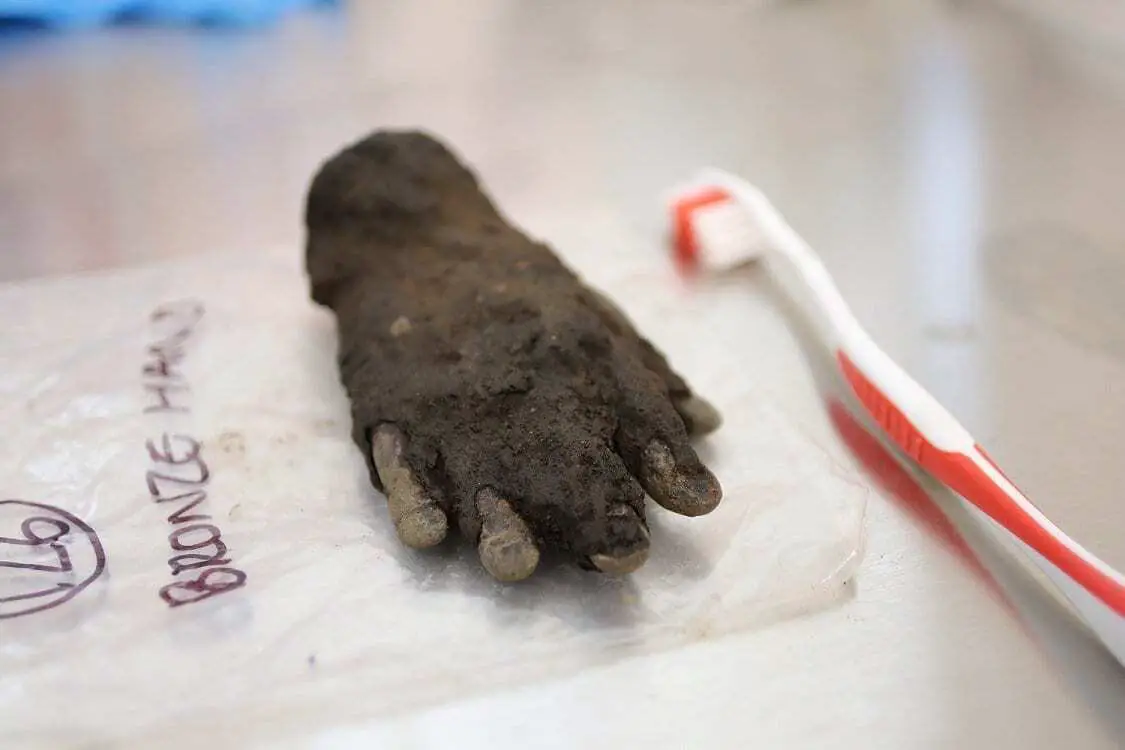A new five-year research excavation started at Roman Vindolanda in April 2018. The research targets the distinct Severan period of Vindolanda’s history c. AD 208-212, an era defined by internal conflict, civil war, genocide and the rebellion against Roman rule.
Vindolanda’s archaeologists, assisted by a team of volunteers from around the world, were only a few weeks into to the excavation season when a remarkable artefact was uncovered in the top layers of the northern Severan ditch fill, some 1.5 meters below the modern-day ground level.
A small, child sized, and eerily life-like bronze hand had been discarded in the ditch. Close inspection of the artefact after conservation at Vindolanda revealed that the 10cm hand originally had an attachment, now missing, inserted into the palm. The hand is very well crafted, especially on the palm facing side, indicating that its purpose was to profile the object that it once held. The base of the hand is socketed and would have been originally fixed to a pole.
The hand was uncovered some metres beyond a temple dedicated to Jupiter Dolichenus, tucked into the northern wall of the third-century fort at Vindolanda which was excavated in 2009. It is now apparent that the newly discovered hand most likely served a cult function and may have been closely associated with Jupiter Dolichenus, a god and mystery cult that was widespread in the Roman Empire from the early 2nd to mid 3rd centuries AD. Comparable examples of votive hands have been found at or close to other temples of Jupiter Dolichenus, although most are slightly larger than the Vindolanda example and some are fortunate to still have inscriptions referring to the god.
Jupiter Dolichenus is depicted holding a thunderbolt in his hand with upraised arm signifying his destructive power, the open votive hand symbolizes the protection and well-being that he could also bring.
Dr Andrew Birley, CEO and Director of Excavations at the Vindolanda Trust commented, “We did not expect to find such a beautifully preserved and rare cult artefact so soon after the start of the 2018 excavation season. When we excavated the nearby temple to Dolichenus in 2009 it was clear that the temple treasures had been removed in Roman times. However, this find being made in a nearby area reminds us that the life of the temple and the practices associated with the worship of Dolichenus had clearly stretched beyond the confines of its stone walls.”
The cult of Jupiter Dolichenus is shrouded in mystery as very little evidence has survived of its myths, liturgies or rituals. All that is known about the religion is based on surviving inscriptions, sculptures or other prices of decorative art from different parts of the Roman Empire. We hope that the continued archaeological investigation of the site at Vindolanda may help to shed more light on the religious practice of Dolichenus in this period of history.
Header Image – Roman bronze hand discovery – Image Credit : Vindolanda Trust





